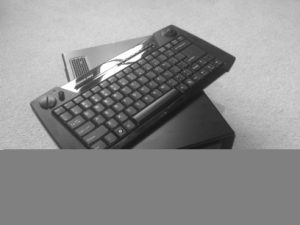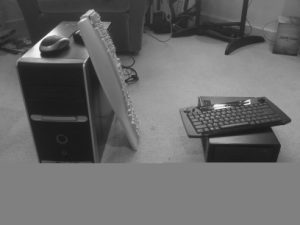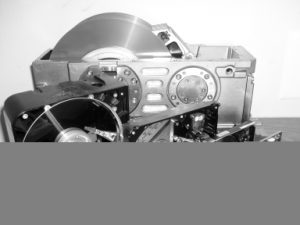This weekend, I integrated two new computers into the home network on New Earth. The first of these is Tiffany2.

Tiffany2 replaces Tiffany, the media centre computer I built a little under four years ago. The original Tiffany was built on a shoestring budget of under £300, and provided the technical magic behind the last hundred or so Troma Nights, as well as countless other film and television nights, a means to watch (and record and pause) live TV, surf the web, and play a game once in a while.
The problem with Tiffany is that she was built dirt-cheap at a time when building a proper media centre PC was still quite expensive. So she wasn’t very good. Honestly, I’m amazed that she lasted as long as she did. And she’s still running: but she “feels” slow (and takes far too long to warm up) and she makes a noise like a jet engine… which isn’t what you want when you’re paying attention to the important dialogue of a quiet scene.

Tiffany2 is virtually silent and significantly more-powerful than her predecessor. She’s also a lot smaller – not much bigger than a DVD player – and generally more feature-rich.
This was the first time I’d built an ITX form-factor computer (Tiffany2 is Mini-ITX): I wanted to make her small, and it seemed like the best standard for the job. Assembling some of her components felt a little like playing with a doll’s house – she has a 2.5″ hard disk and a “slimline” optical drive: components that in the old days we used to call “laptop” parts, which see new life in small desktop computers.

In order to screw in some of the smaller components, I had to dig out my set of watchmaker’s screwdrivers. Everything packs very neatly into a very small space, and – building her – I found myself remembering my summer job long ago at DesignPlan Lighting, where I’d have to tuck dozens of little components, carefully wired-together, into the shell of what would eventually become a striplight in a tube train or a prison, or something.
She’s already deployed in our living room, and we’ve christened her with the latest Zero Punctuation, a few DVDs, some episodes of Xena: Warrior Princess, and an episode of Total Wipeout featuring JTA‘s old history teacher as a contestant. Looks like she’s made herself at home.
(for those who are sad enough to care, Tiffany2 is running an Intel Core i3-2100 processor, underclocked to 3GHz, on an mITX Gigabyte GA-H61N-USB3 motherboard with 4GB RAM, a 750GB hard disk, and DVD-rewriter, all wrapped up in an Antec ISK 300-150 case with a 150W power supply: easily enough for a media centre box plus some heavy lifting if I ever feel the need to give her any)
I used to have my desktop hooked up to my TV by an insanely long HDMI cable (hurray for eBay) but I’ve since switched to just using an Apple TV and blu-ray player and don’t really miss it. Media centre PCs feel a bit old fashioned to me now, did you consider one of the more cloud/network streaming based solutions?
Yeah, I used to have a similar set-up going on, before I built Tiffany, by which the TV was set up as my second monitor for my desktop PC (then Duality or Dualitoo, depending on how far back we’re talking, as I hadn’t yet built Nena).
Media centre PCs only seem only-fashioned to you because of the way you’re choosing to define them. Tiffany2 probably will spend most of her time doing cloud/network streaming. What I wanted was a box that does everything that I’d want from an Apple TV (or similar), plus everything I wanted from an optical player. But I looked at all of the proprietary options and didn’t like any of them (Apple TV came closest, but iTunes still makes me want to hurl, so didn’t quite make it; Google TV fails to put the “TV” into TV; Roku lacks the programmability that I’d desire; blah blah blah). I like to be able to play video in any format I choose, surf the web, watch DVDs, open up my Steam account and play some Beat Hazard on the big screen, listen to music, show off photos, download torrents and stuff off Usenet, remotely control my box from anywhere in the world, watch and record TV, and – occasionally – run apps from it.
I couldn’t find any way to get all of this into one box without building my own! That it also doubles as a nice central print server for our house is just an added bonus. And from my perspective, the cost difference pays for itself just in the bonus of having “another computer” around: Tiffany, for example, made herself very useful as an ad-hoc fileserver during a Code Week last year.
So in short: yes. I’ve played with a few (my mum and hey boyfriend each have one, now), but none of them seem to have as much “oomph” and sheer versatility as I like. Someday they’ll get there, I’m sure: but that day isn’t today.
There certainly are trade offs when it comes to using a set-top box type solution vs a full fledged PC, and if you want to run it as a print or file server then it’s the only fully integrated solution I can think of. On the upside though you don’t have to worry about maintaining a dedicated PC, get something much smaller, silent running and more power efficient (Apple TV’s max draw is 6W for example).
Agreed.
Dana – the box I’ll be writing about in an upcoming blog post – has a maximum draw of 5W. And that includes the monitor. She idles at around 1.5W. But more on that later.
Sounds interesting I look forward to reading it :)
The other thing (other than building Tiffany2 and a second computer, to be described later) that happened last weekend, of course, is that it was my birthday! I share my birthday with David Bowie and Elvis Presley, so if you were ever looking for evidence about how astrology is bullshit: that’s it right there (I have no musical talent whatsoever, although I’m pretty good at Guitar Hero).
I didn’t organise myself a surprise birthday party this year, but instead had a quiet – but drunken – afternoon in with the Earthlings. Ruth had asked me earlier in the week, though, if “there’s anything special that I’d like to eat?” And, of course, I answered:
“A gingerbread village under assault from enormous gelatinous bunny rabbits!”
This was a convenient request, because we already had a lot of the ingredients to-hand. So Ruth and I spent some time building, decorating, and demolishing exactly such a scene.
Gummy-bear citizens gather around a candle lamp-post in the gingerbread village. Little do they know of the horror that approaches…The village, under construction. The first bunny came out a little wet, so we decided that it was dead already, recently slain by the villagers.Armed villagers spear the red bunny.The green bunny, its maw dripping with gummy blood, advances through the ruins of the damaged North side of the village.The first casualty; his gummy friends stand shocked around him. But with the orange bunny about to reach the South flank, there’s nowhere to retreat: they must stand and fight!The orange bunny proves to be a challenge to deploy. More warm water is needed.The village is lit as the battle against the bunnies continues throughout the night.
This, you see, is what happens when I’m given cocktail-making equipment and supplies for my birthday. Nothing makes this kind of activity make sense so much as spending the whole day drinking champagne cocktails.
I’m not sure if it’s better or worse that as the scene came together I began developing a ruleset for a tabletop wargame playable using gummy sweets.
In any case, it was a fantastic way to see in the beginning of my thirty-second year.
Read more →